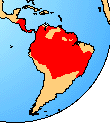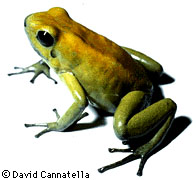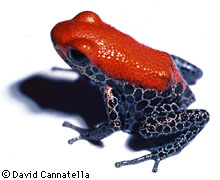Dendrobatidae
Poison-arrow frogs, Dart-poison frogs, Poison-dart frogs
David Cannatella- Aromobates
- Colostethus
- Dendrobates
- Epipedobates
- Mannophryne
- Minyobates
- Phyllobates
Introduction
Dendrobatids are also known as poison-arrow, arrow-poison, and dart-poison frogs. As a group they are the most brightly colored of frogs. Dendrobatids are generally small species, about 20 to 40 mm in snout-vent length. They are also mostly diurnal, and observed hopping on the forest floor by day. A few species are arboreal, or at least partly so. They range from Nicaragua to the Amazonian Bolivia, the Guianas, and SE Brazil. There are no fossils.
Many dendrobatids are brightly colored (and presumably poisonous to some degree). However, there are many dull-colored species in the genus Colostethus, mostly brownish, that do not appear to be poisonous. Indians of the Emberá Chocó in Colombia rub their blowgun darts onto the backs of Phyllobates terribilis to load the darts with poison (Myers et al., 1978).
The reproductive behaviors are diverse. In all species of dendrobatids for which data are known, the tadpoles are carried on the back of the adult. In some species it is the male; in others it is the female that carries the tadpoles. Generally the tadpoles are transported to a body of water, usually a stream, but also small ponds, the water-filled axils of bromeliads or some other small container, in the case of some Dendrobates. The female will transport one tadpole at a time in this way, and there is only one tadpole per crevice. These tiny hiding places offer little in the way of food resources to the developing larva, and the female has evolved the remarkable behavior of depositing unfertilized eggs in the axil to feed the developing tadpole. The normal beaks and denticles that are found in most tadpoles are reduced or lost in these bromeliad-developers.
Geographic Distribution
The distribution of living members of the family Dendrobatidae is indicated in red.

Discussion of Phylogenetic Relationships
Ford and Cannatella (1993) defined Dendrobatidae to be the node-based name for the most recent ancestor of Allobates, Aromobates, Colostethus, Dendrobates, Epipedobates, Minyobates, Phobobates, and Phyllobates, and all of its descendants. Synapomorphies include the presence of a retroarticular process of mandible, and the arrangement of the superficial slip of the m. depressor mandibulae (Ford, 1989b; Myers and Ford, 1986). Other features that have been argued to support monophyly include the tendon of the semitendinosus piercing the mm. gracilis major and minor (Noble, 1922), egg attendance culminating in the transport of aquatic larvae on the dorsum of the parent (Weygoldt, 1987), divided dermal scutes on dorsal surfaces of fingers, and cephalic amplexus (Duellman and Trueb, 1986).
The retroarticular process and conformation of the depressor mandibulae muscle are unique to dendrobatids. The use of other features as synapomorphies assumes that the similar conditions observed in other neobatrachians are convergent. The thigh muscle pattern has been reported in some myobatrachids, some Physalaemus, and Crossodactylus (Lynch, 1971, 1973). However, L. Ford has observed the "bufonoid" condition in Crossodactylus. Dorsal transport of the larva is reported in Rana microdisca, Cyclorhamphus stejnegeri, and Sooglossus seychellensis (Duellman and Trueb, 1986) but Weygoldt (1987) emphasized that dendrobatid parental care was unique in its behavioral complexity. Divided finger scutes have been reported in other frogs, such as hylodine leptodactylids and some myobatrachids (Lynch, 1971).
Data for the amplexus character are meager, but its presence in putative basal (Colostethus) and more deeply embedded taxa (Epipedobates and Phyllobates) suggests that cephalic amplexus is ancestral for Dendrobatidae; its condition in Aromobates nocturnus, the putative sister-group of all other dendrobatids, is unknown (Myers et al., 1991). Two closely related species of Dendrobates lack amplexus (Duellman and Trueb, 1986), but this is probably derived within Dendrobatidae. The less parsimonious alternative is that the cephalic amplexus of dendrobatids is independently evolved from amplexus in other frogs. These and other diagnostic characters of Dendrobatidae were discussed by Ford (1989b).
Relationships of Dendrobatidae to other neobatrachians have been controversial. Griffiths (1959b) allied Dendrobatidae to petropedetine ranids. Noble (1926, 1931) and Lynch (1971, 1973) argued that dendrobatids were derived from hylodine leptodactylids. Following Griffiths, Duellman and Trueb (1986) placed Dendrobatidae with ranoids, although not explicitly with petropedetines. Laurent (1979, 1986) included Dendrobatidae among hyloids, rather than in ranoids. Dendrobatids have a cartilaginous sternum, horizontal pupil, fused second distal carpal, fused second distal tarsal, and an unnotched tongue, all of which are plesiomorphic at the level of Ranoidea. These data do not refute the placement of Dendrobatidae in Ranoidea, but rather suggests that, like Microhylidae, dendrobatids are not nested within Laurent's Ranidae or Hyperoliidae.
Ford (1993) reviewed the controversy concerning the placement of dendrobatids and analyzed the relevant characters in support of each hypothesis. The position of Dendrobatidae was addressed by Ford (1989b) in a phylogenetic analysis of neobatrachians, with an emphasis on ranids and leptodactylids. She concluded that dendrobatids were nested within Ranoidea, close to arthroleptid and petropedetine ranoids.
References
Click here for general list of references
Title Illustrations

1. Phyllobates bicolor; photo copyright © 1995 David Cannatella
2. Dendrobates reticulatus; photo copyright © 1995 David Cannatella
| Copyright |
© 1995 David Cannatella

|
|---|
| Copyright |
© 1995 David Cannatella

|
|---|
About This Page
David Cannatella

University of Texas, Austin, Texas, USA
Correspondence regarding this page should be directed to David Cannatella at
Page copyright © 1995 David Cannatella
 Page: Tree of Life
Dendrobatidae. Poison-arrow frogs, Dart-poison frogs, Poison-dart frogs.
Authored by
David Cannatella.
The TEXT of this page is licensed under the
Creative Commons Attribution License - Version 3.0. Note that images and other media
featured on this page are each governed by their own license, and they may or may not be available
for reuse. Click on an image or a media link to access the media data window, which provides the
relevant licensing information. For the general terms and conditions of ToL material reuse and
redistribution, please see the Tree of Life Copyright
Policies.
Page: Tree of Life
Dendrobatidae. Poison-arrow frogs, Dart-poison frogs, Poison-dart frogs.
Authored by
David Cannatella.
The TEXT of this page is licensed under the
Creative Commons Attribution License - Version 3.0. Note that images and other media
featured on this page are each governed by their own license, and they may or may not be available
for reuse. Click on an image or a media link to access the media data window, which provides the
relevant licensing information. For the general terms and conditions of ToL material reuse and
redistribution, please see the Tree of Life Copyright
Policies.
Citing this page:
Cannatella, David. 1995. Dendrobatidae. Poison-arrow frogs, Dart-poison frogs, Poison-dart frogs. Version 01 January 1995 (under construction). http://tolweb.org/Dendrobatidae/16956/1995.01.01 in The Tree of Life Web Project, http://tolweb.org/










 Go to quick links
Go to quick search
Go to navigation for this section of the ToL site
Go to detailed links for the ToL site
Go to quick links
Go to quick search
Go to navigation for this section of the ToL site
Go to detailed links for the ToL site